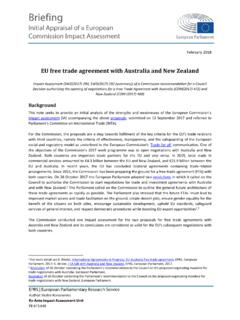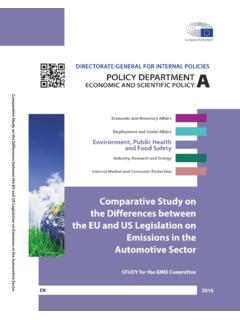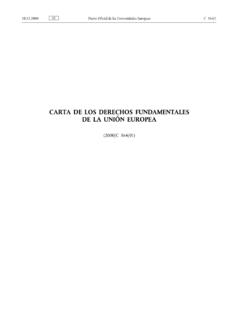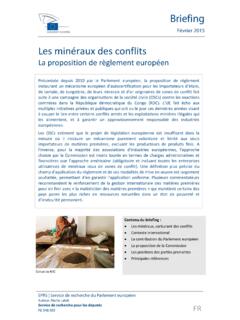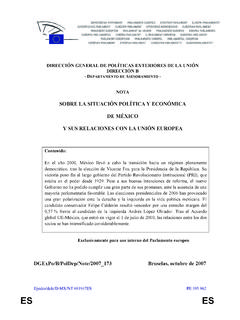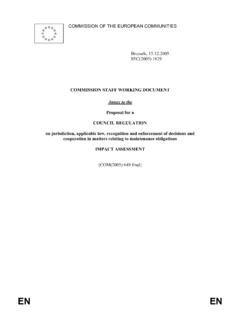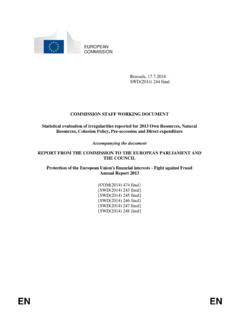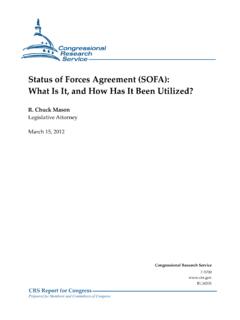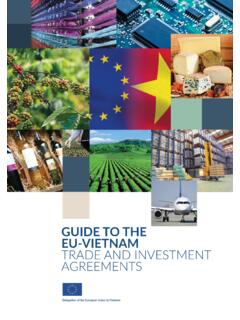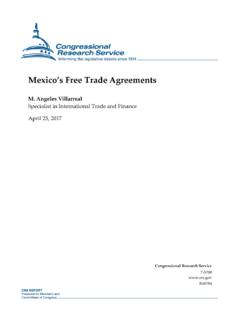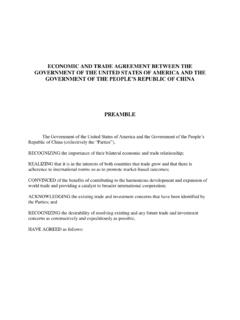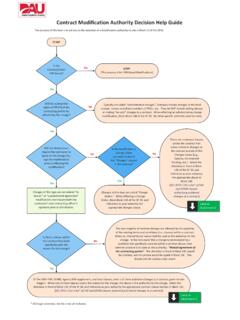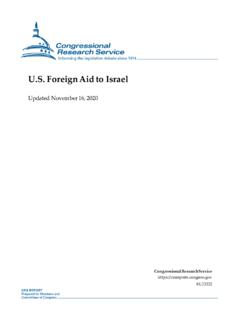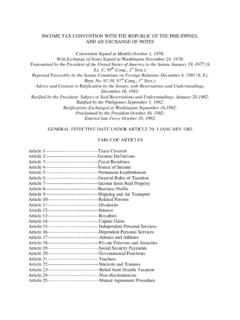Transcription of EU-China Comprehensive Agreement on Investment
1 BRIEFING International Agreements in Progress EPRS | European Parliamentary Research Service Author: Gisela Grieger Members' Research Service PE September 2020 EN EU China Comprehensive Agreement on Investment Levelling the playing field with China OVERVIEW Lack of reciprocity in access to the Chinese market and the absence of a level playing field for EU investors in China have posed major challenges for EU-China Investment relations in recent years, with the negotiation of a Comprehensive Agreement on Investment (CAI) being considered by the EU a key instrument to remedy this state of play. The CAI negotiations are aimed at establishing a uniform legal framework for EU-China Investment ties by replacing the 25 outdated bilateral Investment treaties (BITs) China and EU Member States concluded prior to the entry into force of the Lisbon Treaty in 2009 when the EU gained competence for most Investment issues.
2 The CAI is intended to go far beyond traditional Investment protection to also cover market access, Investment -related sustainable development, and level playing field issues, such as transparency of subsidies, and rules on state-owned enterprises (SOEs) and forced technology transfer. Although leaders at the 2019 EU-China Summit jointly committed to concluding the CAI talks in 2020, lack of engagement at the highest political level on the Chinese side has raised doubts as to whether a breakthrough can be reached in time, with China more focused on navigating the uncertainties of its relations with the United States from January 2021. Comprehensive Agreement on Investment between the European Union and its Member States, of the one part, and the People's Republic of China, of the other part Committee responsible: Rapporteur: International Trade (INTA) Iuliu Winkler (EPP, Romania) EPRS | European Parliamentary Research Service 2 Lack of reciprocity in market access and a level playing field The EU has a principled policy of openness of its market to foreign direct Investment (FDI) as a major source of growth and innovation, while China's FDI framework is regularly gauged by the Organisation for Economic Co-operation and Development (OECD) as one of the most restrictive of the countries investigated.
3 From a legal point of view, however, China is largely free to restrict market access for FDI as it sees fit. First, there is no multilateral Investment Agreement setting out binding rules for market access or Investment protection; an initiative launched in 1995 for negotiations on a multilateral Investment Agreement (MAI) failed in 1998 owing mainly to incompatible positions on Investment protection standards between developing and developed countries. Second, China made limited commitments under the General Agreement on Trade in Services (GATS) (establishment of commercial presence in the partner country (mode 3) with the objective of providing services) and the Agreement on Trade-Related Investment Measures (TRIMS) Agreement (which does not regulate Investment , but rather addresses Investment measures that may distort trade) when it joined the World Trade Organization (WTO) in In the past few years, China has proceded to selective reforms ( removal of ownership limits in the financial sector)
4 And sector-specific market openings, by shortening the restricted and prohibited sectors on the various 'negative lists' applicable to foreign investors or to all investors in China. It adopted a new Foreign Investment Law in 2019, which entered into force in January 2020. The law for the first time prohibits forced technology transfer, a long-standing issue for foreign businesses operating in China and which has given rise to two WTO cases, brought against China by the EU (DS549) and the United States (US) (DS542). The implementing regulations for the new law emphasise equal treatment of domestic and foreign-invested firms with regard to land supply, government procurement, licensing formalities and protection of intellectual property among others, but only time will show whether the law will make a difference for EU firms on the ground.
5 Recent reforms notwithstanding, China's domestic laws differentiate between rules for foreign companies, domestic private companies and domestic state-owned or state-controlled companies, with an inbuilt logic of discrimination against the former to the advantage of the latter. This sharply contrasts with EU company law and EU competition law which do not distinguish between foreign and EU companies, be they private or public, under a concept of 'competitive neutrality' currently not embraced by China. The lack of a level playing field for EU companies in China as compared to Chinese firms in the EU where the latter benefit from the non-discrimination principle enshrined in EU law has become a major bone of contention in EU-China relations. EU State aid rules are not applicable to foreign companies, including Chinese (state-owned) enterprises benefiting from domestic subsidies to pursue strategic government goals, notably industrial policy objectives.
6 In addition to the CAI talks, much more EU action is needed in various policy areas to tackle these challenges. Moreover, in recent years China has enacted a series of security-related laws (the National Intelligence Law and the Cyber Security Law) and regulations that may hamper the operation and freedom of Investment of foreign firms, in addition to the existing FDI restrictions, thus potentially offsetting past gradual steps towards liberalisation. This trend is compounded by China's ambitious state-sponsored industrial strategy Made in China 2025, aimed at significantly reducing the country's reliance on foreign technology by replacing it with indigenous technology in several strategic high tech sectors. Other restrictions looming on the horizon, such as the country-wide rollout of a corporate social credit system, is set to further complicate the Investment climate for EU business in China.
7 The EU considers the CAI a major tool to address these issues and rebalance EU-China economic relations. However, while the EU has been calling for reciprocal market access and equal treatment for EU firms in China, China has regularly dismissed these calls on the grounds that its developing country status justifies the lack of reciprocity. As China boasted the world's second largest economy at US$ trillion in 2019, its self-declared developing country status is increasingly contested. EU-China Comprehensive Agreement on Investment 3 EU-China legal framework for Investment At present, the EU-China legal framework covers only Investment protection based on the 25 bilateral Investment treaties (BITs) that EU Member States signed with China before the EU gained competence for FDI under the 2009 Treaty of Lisbon, within the boundaries set by the 2017 Opinion 2/15 of the Court of Justice of the European Union (CJEU).
8 There are no bilateral provisions on Investment liberalisation in force, since the 1985 EU-China Agreement on Trade and Economic Cooperation does not contain market access provisions for As a result, the current EU China legal framework does not cover market access and the 25 BITs in force are outdated and reflect neither recent developments in the EU's and China's Investment policy, major shifts in the bilateral and international Investment relations or geopolitical changes. The 25 BITs are applicable to 26 EU Member States, since Belgium and Luxembourg share one BIT and Ireland has no BIT with China, as it concluded only one BIT with a foreign country, the Czech Republic, in 1996. The 25 BITs share a similar structure of substantive and procedural protection standards, largely following the Dutch 'gold standard' model BIT.
9 Eight older BITs were replaced by slightly updated BITs, while some older BITs were selectively upgraded by a protocol and again others have never seen an update. The 25 BITs can be classified into two generations of BITs (Table 1 below displays them in grey and blue). The more recent BITs (blue) can be distinguished from the older BITs (grey) by two major changes: First, post-establishment national treatment (NT) is granted, which is generally aimed at equal treatment between domestic and foreign Investment and is not included in older BITs or if so only as a vague 'best effort' clause; however, the scope of application of most recent NT clauses is limited asymmetrically for EU companies by grandfathered Chinese non-conforming measures or by a general reference to overriding Chinese law which typically discriminates against foreign investors.
10 Second, after China acceded to the International Centre for Settlement of Investment Disputes (ICSID) Convention in 1993, it gradually granted access to investor-state dispute settlement (ISDS) for any dispute under certain conditions ( completion of a Chinese administrative review and prohibition on pursuing claims both via national courts and ISDS 'fork in the road' clause). In older BITs access to international arbitration is often constrained to disputes about the amount of the compensation for expropriation, and the state parties' mutual consent or the exhaustion of local remedies are required. It is worth noting that despite China's embrace of ISDS, EU firms' significant Investment stock in China, and China's low rule of law ranking, the 2017 Hela Schwarz vs.
